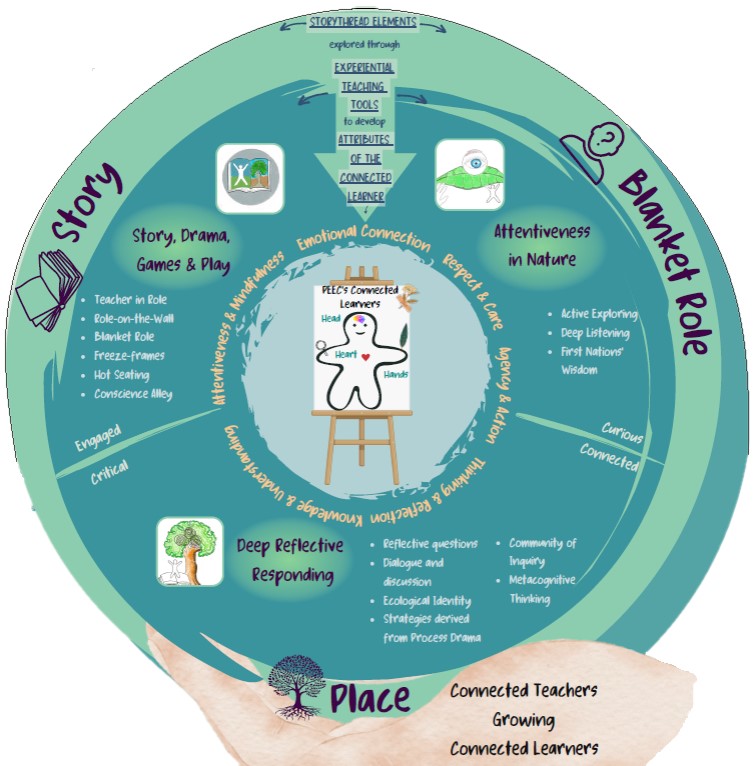Storythread is a 'place responsive pedagogy' that uses story to connect students to nature and generate deep learning through Dadirri* and Attentiveness to inspire action for Nature.

* The word, concept and spiritual practice that is dadirri (da-did-ee) is from the Ngan'gikurunggurr and Ngen'giwumirri languages of the Aboriginal peoples of the Daly River region (Northern Territory, Australia). We have been gifted permission from the Miriam Rose Foundation to share Dadirri. Whilst we acknowledge there may be a local language word more appropriate to the lands on which we teach, in the absence of this being gifted to us by local Elders, our consulting Elders here at PEEC support our vision to share Dadirri. If you speak of Dadirri, please be mindful of respectful protocol, including acknowledging the original source and seeking your own permission from the Foundation. You can find out more at the official site of the Miriam Rose Foundation.
How do we grow our Connected Learners?
STORY: Learners step into story and solve critical problems relating to nature as the mentor character (their blanket role).
Woven through each PEEC Storythread is a story (either fiction or non-fiction) that introduces and carries environmental issues and ideas. The story is a powerful medium that can excite and engage students. It provides opportunities to explore environmental ideas and issues through the characters’ perspectives and encourages deep thinking and discussion.
Engaging with characters in an environmental narrative and reflecting on the impact of their choices and actions, gives students a way of discussing and reviewing their own environmental values and understandings. Significantly, students are encouraged to transfer learnings to their own lives.
The story form is a cultural universal; everyone, everywhere enjoys stories. The story, then, is not just some casual entertainment; it reflects a basic and powerful form in which we make sense of the world and experience.
–Egan, 1988, p.20
BLANKET ROLE: The role provides a provocation for nature connection and care, and through story, awakens students' voice and agency promoting deep learning and respect.
Students begin their Storythread journey by receiving an invitation to take on a specified real-life ‘blanket role’ e.g. ‘Nature Kid’, ‘Nature Detective’, ‘Environmental Advocate’. The blanket role inspires students to inquire, predict, influence and reflect on the Pullenvale Environmental Education Centre (PEEC) stories and their own experiences of place through scaffolded dialogues that shape future knowledge, values and actions.
We have found that taking on a real-life ‘blanket role’ engages, excites and empowers students.
Each ‘blanket role’ requires students to think of themselves in new ways as Connected Learners who value and respect the connections between self, others and place.
PLACE: Anywhere beyond the classroom where students are able to make a personal connection to the natural world.
‘Place’ is always our starting point and our inspiration. For us ‘place’ can mean a blade of grass, a tree, garden, school ground, park, local creek, remnant forest, right through to wilderness, anywhere in fact where natural systems exist.
Places are pedagogical:
People, and others species, live emplaced lives, and an analysis of place reveals the many ways that places are profoundly pedagogical. That is, as centres of experience, places teach us and shape our identities and relationships.
– reenwood in Stevenson et al., 2012
Place as Text… we read the world…
Teachers who are place based recognize the educational potential of teaching and learning outside the classroom. For them, community and place become additional 'texts' for student learning.
–Smith, 2012
CURRICULUM:
As an Education Queensland facility, PEEC aligns all programs, which are designed and taught by qualified teachers, with the Australian Curriculum and QCAA guidelines. At PEEC, our programs are framed around the 'Blanket Role', which becomes the reason for students to engage deeply with the curriculum and inspires empowered and purposeful learning, student voice and agency.
Students and teachers grow as Connected Learners who:
- respect First Nations' wisdom
- are curious relational thinkers
- apply an ethic of care
- focus on the inner and outer work of sustainability

How do we measure our impact and ensure continuous improvement?
AUTHENTIC ASSESSMENT: What are we assessing and why?
TEACHING EXCELLENCE: How do we continue to grow?
- Mentor-supported, structured rehearsal and training periods explicitly addressing current best practice (including other informing pedagogies), curriculum alighnment, ecology and sustainability, drama pedagogy, inclusion, trauma-informed practice and First Nations' wisdom and perspectives
- Targeted professional development
- Individual and collegial teaching and learning observations, reflection, improvement and celebration